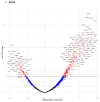Proteomic Associations of NT-proBNP (N-Terminal Pro-B-Type Natriuretic Peptide) in Heart Failure With Preserved Ejection Fraction
- PMID: 38299345
- PMCID: PMC7615693
- DOI: 10.1161/CIRCHEARTFAILURE.123.011146
Proteomic Associations of NT-proBNP (N-Terminal Pro-B-Type Natriuretic Peptide) in Heart Failure With Preserved Ejection Fraction
Abstract
Background: NT-proBNP (N-terminal pro-B-type natriuretic peptide) levels are variably elevated in heart failure with preserved ejection fraction (HFpEF), even in the presence of increased left ventricular filling pressures. NT-proBNP levels are prognostic in HFpEF and have been used as an inclusion criterion for several recent randomized clinical trials. However, the underlying biologic differences between HFpEF participants with high and low NT-proBNP levels remain to be fully understood.
Methods: We measured 4928 proteins using an aptamer-based proteomic assay (SOMAScan) in available plasma samples from 2 cohorts: (1) Participants with HFpEF enrolled in the PHFS (Penn Heart Failure Study; n=253); (2) TOPCAT (Treatment of Preserved Cardiac Function Heart Failure With an Aldosterone Antagonist Trial) participants in the Americas (n=218). We assessed the relationship between SOMAScan-derived plasma NT-proBNP and levels of other proteins available in the SOMAScan assay version 4 using robust linear regression, with correction for multiple comparisons, followed by pathway analysis.
Results: NT-proBNP levels exhibited prominent proteome-wide associations in PHFS and TOPCAT cohorts. Proteins most strongly associated with NT-proBNP in both cohorts included SVEP1 (sushi, von Willebrand factor type-A, epidermal growth factor, and pentraxin domain containing 1; βTOPCAT=0.539; P<0.0001; βPHFS=0.516; P<0.0001) and ANGPT2 (angiopoietin 2; βTOPCAT=0.571; P<0.0001; βPHFS=0.459; P<0.0001). Canonical pathway analysis demonstrated consistent associations with multiple pathways related to fibrosis and inflammation. These included hepatic fibrosis and inhibition of matrix metalloproteases. Analyses using cut points corresponding to estimated quantitative concentrations of 360 pg/mL (and 480 pg/mL in atrial fibrillation) revealed similar proteomic associations.
Conclusions: Circulating NT-proBNP levels exhibit prominent proteomic associations in HFpEF. Our findings suggest that higher NT-proBNP levels in HFpEF are a marker of fibrosis and inflammation. These findings will aid the interpretation of NT-proBNP levels in HFpEF and may guide the selection of participants in future HFpEF clinical trials.
Keywords: biomarkers; fibrosis; heart failure; inflammation; proteomics.
Conflict of interest statement
Figures






Comment in
-
Ongoing Enigma of NT-proBNP in HFpEF: Insights From Proteomics.Circ Heart Fail. 2024 Feb;17(2):e011428. doi: 10.1161/CIRCHEARTFAILURE.123.011428. Epub 2024 Feb 1. Circ Heart Fail. 2024. PMID: 38299326 Free PMC article. No abstract available.
References
-
- Paulus WJ, Tschöpe C. A novel paradigm for heart failure with preserved ejection fraction: Comorbidities drive myocardial dysfunction and remodeling through coronary microvascular endothelial inflammation. Journal of the American College of Cardiology. 2013;62:263–271. - PubMed
-
- Januzzi JL, Myhre PL. The challenges of nt-probnp testing in hfpef. JACC: Heart Failure. 2020;8:382–385. - PubMed
Publication types
MeSH terms
Substances
Grants and funding
- K23 HL133843/HL/NHLBI NIH HHS/United States
- R01 HL155599/HL/NHLBI NIH HHS/United States
- R03 HL146874/HL/NHLBI NIH HHS/United States
- R01 HL104106/HL/NHLBI NIH HHS/United States
- R01 HL121510/HL/NHLBI NIH HHS/United States
- R56 HL136730/HL/NHLBI NIH HHS/United States
- R01 AG058969/AG/NIA NIH HHS/United States
- R01 HL153646/HL/NHLBI NIH HHS/United States
- R01 HL141232/HL/NHLBI NIH HHS/United States
- 100114/WT_/Wellcome Trust/United Kingdom
- P01 HL094307/HL/NHLBI NIH HHS/United States
- R01 HL157264/HL/NHLBI NIH HHS/United States
- U01 HL160277/HL/NHLBI NIH HHS/United States
- R01 HL149722/HL/NHLBI NIH HHS/United States
- R01 HL088577/HL/NHLBI NIH HHS/United States
- UH3 DK128298/DK/NIDDK NIH HHS/United States
- R33 HL146390/HL/NHLBI NIH HHS/United States
LinkOut - more resources
Full Text Sources
Medical
Research Materials

